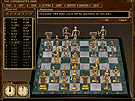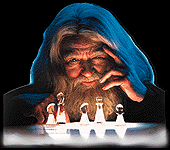

Chess is arguably the oldest game in the world and perhaps the most popular. One of the first games that I ever learned was Chess from my father, and it was one of the most important memories of those early days. The love of chess that my father transferred to me at the age of six has stayed with me through playing on the chess team at high school and later in college.
Many of us who have had strong roots in chess moved on and out to other games, the 3M bookshelf games, the Simulations Publications Incorporated games, Avalon Hill games, Clue, Monopoly, Risk, Life, and many others that still adorn my shelves and those of many others. But Chess still acts as a magnet and an anchor in many gamerís life and again and again we find ourselves turning to chess.
One of the problems of playing any game against a human is finding a player who approximates your level of play (see "rating system" below). Many have turned away from chess because they could not find someone that approximated their level of play. One alternative is to play-by-mail, later we could play by modem, even later still we could play on online services, and now we have the internet. So there are no more excuses for you to leave that set in the closet. Get back into chess.
The Game Engine: True 32-bit engine for Chessmaster 5000 (CM5000) is
optimized for Pentium chip play, but which will, albeit at a lower
level, accommodate the older 486DX technology.

Clocks: Many different clocks are available. You can set the clock to any time for yourself and any time for your component. Progressive handicapping of yourself or the computer is a good way to learn. Special clocks are also supported, including the Fischer clock and the hourglass clock.
Rating System: Most good to excellent chess players are rated by their level of play so that other players will know who is way beyond or below them and who is just right to play a game against, since it isnít very much fun to beat a human opponent to easily or to be trounced repeatedly. Many computer chess games have rating systems that help you to compare yourself to the other good to excellent chess players out there. CM5000 has a rating system that compares your moves to those of Grand Master status. The flaw in this rating system is that many chess players study chess by memorizing the moves of Grand Masters but lack the greater finesse to make the correct choice between Grand Master moves in live play. Thus the rating system of CM5000 would rate those who memorize higher than those who play by the seat of their pants, and not by really how they perform in live play.
Opponents (computer): About 75 computer opponents are available which are programmed to play in the style and personality of the Grand Masters, including Alekhine, Anderssen, Bird, Capablanca, Morphy, Spassky, Fischer, Nimzovitch, and Kasparov. The simulated Grand Master styles which are most accurate portrayals of the real people, but realistically could never simulate them in live play, because a computer does not have the GM intuition, hunches, and aggressiveness. Other than Grand Master styles, a player of CM5000 can choose to adjust statistical attributes, including control of the center, King safety, protection value of each piece, strength, and mobility. While the artificial intelligence is not up to the Big Blue standard, it is quite impressive and an aid to learning for any level of chess skill. Normal midlevel players are also supported with general styles, including light, moderate, easy, kamikaze, and others, for those who find themselves not up to the Grand Master simulacula.
Editor: An opponent editor that controls a large number of factors can
be used to attempt to recreate the playing profile of any player or
Grand Master. However, the subtleties of this type of construction may
escape the novice or even good player without a lot of study of the
chess literature.

Tutorials: An extensive library of moves that take beginners and advanced players on the tour of the principles, such as how to control the center, importance of the different ranks, passed pawns, pawn structure, and strong versus weak squares. Advice is given by Grand Masters John Nunn and Yasser Seirawan including commentary on the 1993 match between Kasparov and Karpov.
Comparisions: How does CM 5000 compare to Battle Chess, the Interplay classic that has spawned numerous versions and clones with its witty and comical animation of the war of chess? Or how does CM5000 stack up to Sargon, one of the first commercially available programs? Can you say "we have come a long way baby?" There are many computer chess programs around, but how many can say they have survived the ten years that CM 5000 has survived. Some may have more impressive data bases in some areas and some may have greater style when animating or graphically representing the chess pieces. But for good solid play CM 5000 is an accomplished classic.
Music: Not very impressive
Multiplayer: 2 player over null and phone modem, network, or internet
References:
Terry Coleman, Computer Gaming World, number 146, September, 1996, pg.
159-160. 5/5 (100%).
Martin Cirilus, Computer Gaming World, July, 1996
www.zdnet.com/gaming/content/960716/mission/mission.html